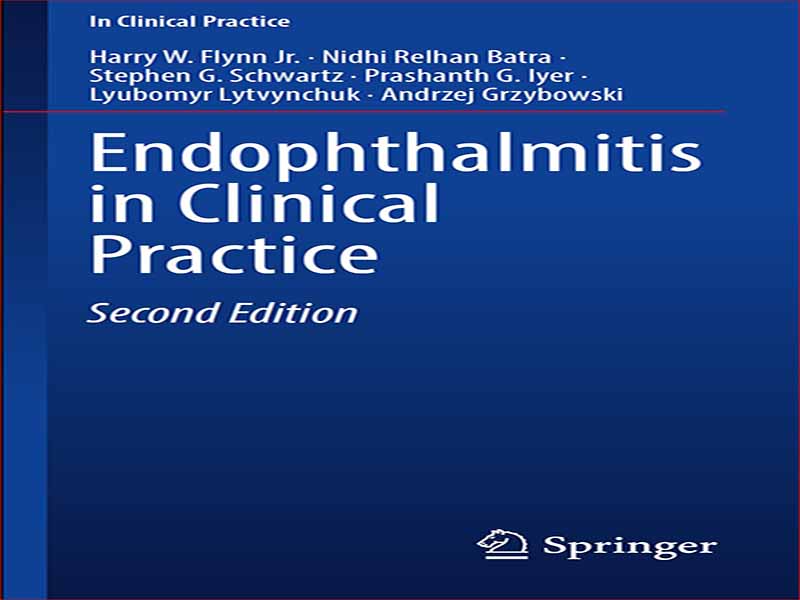- عنوان کتاب: Endophthalmitis in Clinical Practice
- نویسنده: Harry W. Flynn Jr
- حوزه: پزشکی بالینی
- سال انتشار: 2023
- تعداد صفحه: 235
- زبان اصلی: انگلیسی
- نوع فایل: pdf
- حجم فایل: 9.98 مگابایت
در طول چند دهه گذشته، ما درک بهتری از پاتوفیزیولوژی عفونتهای داخل چشمی از طریق مطالعات بالینی و میکروبیولوژیکی داشتهایم و میتوانیم تشخیص و درمان سریعتری را برای بهبود نتایج در مدیریت اندوفتالمیت آغاز کنیم. مشاهده تغییرات در تشخیص های افتراقی و مدیریت اندوفتالمیت در سال های اخیر شگفت انگیز است. با افزایش روش های تهاجمی چشمی، نیاز به یک مرجع مختصر و به روز در مورد اندوفتالمیت بالینی وجود دارد که شامل گزینه هایی برای درمان ضد میکروبی و نقش ویترکتومی پارس پلانا باشد. این کتاب با عنوان اندوفتالمیت در عمل بالینی به خوبی پاسخگوی نیاز است. چندین فصل در کتاب به موضوعات فرعی خاصی در مدیریت اندوفتالمیت اختصاص دارد. بخش پیشینه شامل اطلاعات تاریخی و همچنین جزئیاتی در مورد مطالعه ویترکتومی اندوفتالمیت (EVS)، و همچنین بحثهای موجود در استفاده از آنتیبیوتیکهای داخل دوربینی در حین جراحی آب مروارید است. این به دنبال بحثی در مورد علل مختلف اندوفتالمیت است و شامل استراتژیهای اولیه درمان در هر زیرگروه است. به عنوان بخشی از ارزیابی تشخیصی، بخشهایی شامل تصویربرداری برای مستندسازی ویژگیهای بالینی، ویژگیهای اکوگرافیک، و عوارض مؤثر بر نتایج بینایی است. مدیریت موارد دشوارتر ممکن است نیاز به درمان مجدد پس از ضد میکروبی های اولیه داشته باشد و به طور غیرمعمول ممکن است نیاز به برداشتن کیسه کپسولی و لنز داخل چشمی (IOL) در موارد خاص باشد. تصاویری از موارد قبل و بعد از درمان از رویه بالینی نویسندگان نشان داده شده است. ویترکتومی پارس پلانا اغلب در مواردی که سریعتر پیشرفت می کنند، به ویژه در اندوفتالمیت پس از عمل جراحی آب مروارید در بیمارانی که با حدت بینایی ادراک نور مراجعه می کنند، مورد توجه قرار می گیرد. استفاده از ویترکتومی ممکن است به دلیل تیرگی قرنیه یا مدیا محدود شود، اما روشهای ویترکتومی با گیج کوچک ممکن است روش سادهتری را برای ویترکتومی مرکزی بدون نیاز به کالبد شکافی ملتحمه یا قرار دادن بخیه امکانپذیر کند. سپس درمان ضد میکروبی مورد بحث قرار می گیرد. این شامل پوشش گسترده اولیه باکتری های گرم مثبت و گرم منفی است. به همین ترتیب، عوامل ضد قارچی از جمله آمفوتریسین B و وریکونازول را می توان در اندوفتالمیت مشکوک یا تایید شده ناشی از قارچ استفاده کرد. عوامل جایگزین برای ارگانیسمهای مقاوم مورد بررسی قرار گرفته و درمان مناسب برای مدیریت بعدی بررسی میشود. استفاده از تزریقات داخل زجاجیه برای بیماری های شبکیه به پیشروترین روش چشم پزشکی در ایالات متحده تبدیل شده است. در این بیماران، اندوفتالمیت می تواند از آلودگی محلول و همچنین از طریق خود روش تزریق رخ دهد. این موارد عموماً در اوایل تزریق ظاهر می شوند و غالباً فلور اوروفارنکس ناشی از آلودگی سوزن یا سطح چشم در حین تحویل دارو را درگیر می کنند. استرپتوکوک و همچنین سایر ارگانیسمهای گرم مثبت در این موارد ممکن است تظاهرات بالینی پیشرفتهتری با پیامدهای بینایی و آناتومیک ضعیف داشته باشند. این متن بدون شک یک دارایی ارزشمند برای چشم پزشکان بالینی و همچنین متخصصان شبکیه خواهد بود. تصاویر بالینی فراوان، جداول مختصر و مواد مرجع خوانایی آن را افزایش میدهد. به استثنای EVS، هیچ کارآزمایی بالینی تصادفی شده عمده ای وجود ندارد که بر اساس آن توصیه های قطعی باشد. در عوض، نویسندگان از سری موارد منتشر شده و تجربیات خود برای ارائه دستورالعملهایی در مورد مدیریت سریع و کارآمد اندوفتالمیت استفاده میکنند.
Over the past few decades, we have a better understanding of the pathophysiology of intraocular infections through clinical and microbiological studies, and we can initiate more prompt diagnosis and treatment to improve outcomes in the management of endophthalmitis. It is amazing to witness the changes in the differential diagnoses and management of endophthalmitis in recent years. With the increases in invasive ophthalmic procedures, there is a need for a concise, up-to-date reference on clinical endophthalmitis which includes options for antimicrobial therapy and the role of pars plana vitrectomy. This book, entitled Endophthalmitis in Clinical Practice, meets the need very well.
Multiple chapters in the book are dedicated to specific subtopics in endophthalmitis management. The background section includes historical information as well as details on the Endophthalmitis Vitrectomy Study (EVS), as well as controversies in the use of intracameral antibiotics during cataract surgery.
This follows a discussion on the various etiologies of endophthalmitis and includes initial treatment strategies in each subgroup. As part of diagnostic evaluation, sections include imaging for documentation of clinical features, echographic characteristics, and complications affecting visual outcomes. Management of more difficult cases may require retreatment after initial antimicrobials and uncommonly may require removal of the capsular bag and the intraocular lens (IOL) in specific cases. Illustrations of pre- and posttreatment cases are shown from the authors’ clinical practice. Pars plana vitrectomy is often considered in more rapidly advancing cases, especially in endophthalmitis after cataract surgery in patients presenting with light perception visual acuity. The use of vitrectomy may be limited by corneal or media opacities, but small-gauge vitrectomy approaches may allow a simpler approach to core vitrectomy without the need for conjunctival dissection or suture placement.
Antimicrobial therapy is then discussed. This includes initial broad coverage of both Gram-positive and Gram-negative bacteria. Likewise, antifungal agents including amphotericin B and voriconazole can be utilized in suspected or confirmed endophthalmitis caused by fungi. Alternative agents for resistant organisms are reviewed and the tailoring of treatment for subsequent management.
The use of intravitreal injections for retinal diseases has become the leading ophthalmic procedure in the United States. In these patients, endophthalmitis can occur from solution contamination as well as from the injection procedure itself. These cases generally present early after injection and frequently involve oropharyngeal flora from contamination of the needle or the ocular surface during drug delivery. Streptococcus as well as other Gram-positive organisms in these cases may have a more advanced clinical presentation with poor visual and anatomic outcomes.
This text will undoubtedly prove to be a valuable asset for clinical ophthalmologists as well as retinal specialists. The abundant clinical illustrations, concise tables, and reference material enhance its readability. With the exception of the EVS, there are no major randomized clinical trials on which to base definitive recommendations. Rather, the authors utilize published case series and their own experience to provide guidelines regarding the prompt and efficient management of endophthalmitis.
این کتاب را میتوانید بصورت رایگان از لینک زیر دانلود نمایید.
Download: Endophthalmitis in Clinical Practice




































نظرات کاربران